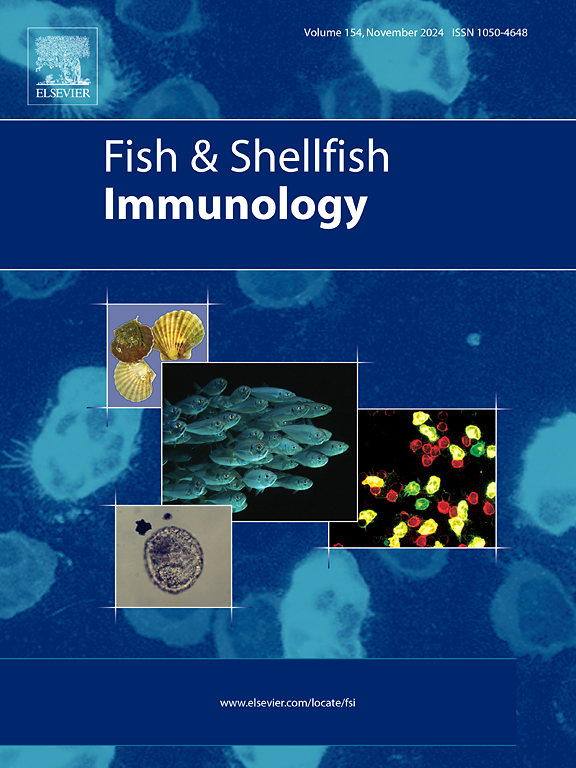Escherichia coli heat-labile enterotoxin B subunit as an adjuvant of mucosal immune combined with GCRV-II VP6 triggers innate immunity and enhances adaptive immune responses following oral vaccination of grass carp (Ctenopharyngodon idella)
IF 4.1
2区 农林科学
Q1 FISHERIES
引用次数: 0
Abstract
The grass carp reovirus (GCRV) is the most major pathogen that has threatened the grass carp (Ctenopharyngodon idella) industry of China for years. Though the oral vaccine has many advantages, the current vaccines still do not provide complete protection. Therefor the exploration of new preventive strategies is urgently needed. In this study, heat-labile enterotoxin B subunit of Escherichia coli (LTB) was combined with VP6 from GCRV type II (GCRV-II) via Lactococcus lactis expression system to form a potent oral vaccine and determines if fusion of LTB to the protective vaccine antigen can enhance protection in the fish. The expression of recombinant protein was confirmed by Western-blotting and enzyme-linked immunosorbent assay. The rare minnow was set as the model for the evaluation of the experiment administrated orally. The immune response including the antibody titer and the immune-related gene expression, and the protective efficacy which included the virus loaded and the relative protection, were thoroughly investigated after the trial. The results indicated that LTB can significantly elicit a higher neutralizing antibody responses and enhanced T-cell priming, activities and proliferation in mononuclear cells from intestine, spleen and kidney tissues when compared to the VP6 vaccine alone. Moreover, the combined adjuvant can significantly up-regulate type I interferon signaling in different immune organs, especially the mucosa associated lymphoidtissue which could not be induced by VP6 along, result in the contribution of the improvement in adaptive immune responses of the fish. In addition, challenge study showed that LTB combined VP6 could greatly improve the relative percent survival of the fish during the virus infection. These results highlight that LTB has the potential value to be a mucosal adjuvant of the fish, approaching for improving the efficacy of vaccination against GCRV-II, which does elicit both non-specific and specific immune responses.
大肠杆菌热嗜性肠毒素 B 亚基作为粘膜免疫佐剂与 GCRV-II VP6 结合使用可触发先天性免疫并增强草鱼口服疫苗后的适应性免疫反应
草鱼再病毒(GCRV)是多年来威胁中国草鱼产业的最主要病原体。虽然口服疫苗有很多优点,但目前的疫苗仍不能提供完全的保护。因此,迫切需要探索新的预防策略。本研究通过乳酸乳球菌表达系统将大肠杆菌的热嗜性肠毒素 B 亚基(LTB)与 GCRV II 型(GCRV-II)的 VP6 结合形成强效口服疫苗,并确定 LTB 与保护性疫苗抗原融合是否能增强鱼类的保护力。通过 Western-blotting 和酶联免疫吸附试验证实了重组蛋白的表达。口服实验以珍稀鱲鱼为模型进行评估。试验后,对包括抗体滴度和免疫相关基因表达在内的免疫反应,以及包括病毒载量和相对保护率在内的保护效力进行了深入研究。结果表明,与单独接种 VP6 疫苗相比,LTB 能显著激发肠道、脾脏和肾脏组织单核细胞产生更高的中和抗体反应,并增强 T 细胞的启动、活性和增殖。此外,联合佐剂还能显著上调不同免疫器官的 I 型干扰素信号,尤其是 VP6 疫苗无法诱导的粘膜相关淋巴组织,从而有助于改善鱼类的适应性免疫反应。此外,挑战研究表明,LTB 联合 VP6 可大大提高鱼类在病毒感染期间的相对存活率。这些结果突出表明,LTB 具有作为鱼类粘膜佐剂的潜在价值,可用于提高 GCRV-II 疫苗接种的效果,因为 GCRV-II 疫苗可引起非特异性和特异性免疫反应。
本文章由计算机程序翻译,如有差异,请以英文原文为准。
求助全文
约1分钟内获得全文
求助全文
来源期刊

Fish & shellfish immunology
农林科学-海洋与淡水生物学
CiteScore
7.50
自引率
19.10%
发文量
750
审稿时长
68 days
期刊介绍:
Fish and Shellfish Immunology rapidly publishes high-quality, peer-refereed contributions in the expanding fields of fish and shellfish immunology. It presents studies on the basic mechanisms of both the specific and non-specific defense systems, the cells, tissues, and humoral factors involved, their dependence on environmental and intrinsic factors, response to pathogens, response to vaccination, and applied studies on the development of specific vaccines for use in the aquaculture industry.
 求助内容:
求助内容: 应助结果提醒方式:
应助结果提醒方式:


